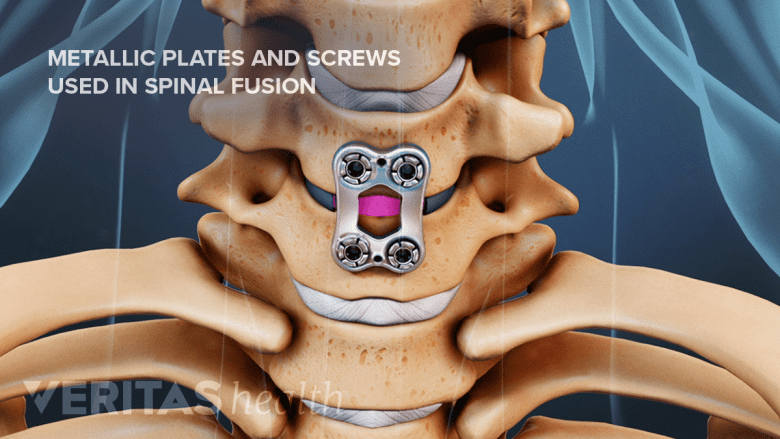External bone growth stimulation devices are worn outside the skin and do not require surgical implantation or extraction.
It may be used as an adjunct for lumbar fusion or cervical spine fusion (an ACDF) to enhance the bone healing process required for a successful fusion to set up.
In This Article:
- How an Electrical Bone Growth Stimulator Helps with Spine Fusion
- Internal Bone Growth Stimulator for Spine Fusion
- External Bone Growth Stimulators for Spine Fusion
What to Know about External Bone Growth Stimulators

Metallic plates and screws are used to provide spinal stability while helping the fusion heal.
An external electrical stimulator is usually lightweight, readily portable, and powered by a battery.
The external device comes in a variety of forms. It may be worn as:
- Small, thin skin pads/electrodes that are placed directly over the fusion site and deliver a type of electrical stimulation called Capacitive Coupling (CC), or;
- One or two treatment coil(s) placed into a brace or directly onto the skin that deliver a type of electromagnetic field called a Pulsed ElectroMagnetic Field (PEMF), or a Combined Magnetic Field (CMF).
Unlike an internal (implanted) bone growth stimulator, an external bone growth stimulator may also be prescribed for the patient to use several weeks or months after the fusion surgery if the bone is not fusing as desired.
See Postoperative Care for Spinal Fusion Surgery
Typically, the external bone growth stimulator will be worn for a period of 3 to 9 months following the fusion surgery, but may be prescribed for longer if needed.
Postoperative Instructions for an External Bone Growth Stimulator
Depending on the device and the patient's situation, an external bone growth stimulator will be prescribed to be worn for a specific number of hours each day. The length of time it needs to be worn varies considerably. For example, some need to be worn for 2 to 4 hours a day, and some for about 30 minutes per day.
Sometimes the patient may be allowed to break it up into several one- or two-hour sessions each day, or to vary the times that the device is worn each day, to better suit the patient’s schedule.
Patients may move about and complete their daily activities as they normally would. However, the patient's activities will usually be restricted by the surgeon due to the fusion surgery.
There are some activities that the patient should remove the device for, such as swimming and taking a shower or bath.
Some devices have an app available that is designed to help patient’s comply with the prescribed therapy regimen.
The stimulator runs on a battery that needs to be recharged periodically.
What Patients Say About External Bone Growth Stimulators
Wearing the external device is not painful and the patient cannot feel any electrical shocks while wearing it.
The device is typically portable and lightweight.
Depending on the type of device, some people report a slight tingling sensation when it is on.
Potential Risks and Adverse Effects
While external electrical stimulation devices are considered generally safe and reliable, it is important to note that the electromagnetic effects carry some potential risks. For example:
- The effect of bone growth stimulation during pregnancy or nursing is not known
- They may impact some types of pacemakers and defibrillators
This is not a complete list of potential issues, and patients are advised to work with discuss this with their doctors.
Pros and Cons of an External Bone Growth Stimulator
A theoretical disadvantage of an external stimulator versus the internal stimulator is that there may be less patient compliance with wearing the external stimulator the required number of hours. Obviously, if the patient does not wear the device, the benefits from the treatment will not be realized.
A potential advantage of external stimulators versus internal stimulators is that the external device is usually a less expensive treatment option and does not require the potential second surgery to remove the battery pack.
The cost of an external bone growth stimulator varies considerably; a typical cost is about $5,000.
Another advantage of an external bone stimulator is that the therapy can be added weeks or months after the fusion surgery if there is an emerging concern that the bone graft is not healing and a nonunion is developing.

